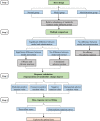Integrated dose-response metabolomics with therapeutic effects and adverse reactions may demystify the dosage of traditional Chinese medicine
- PMID: 36403018
- PMCID: PMC9675273
- DOI: 10.1186/s13020-022-00687-4
Integrated dose-response metabolomics with therapeutic effects and adverse reactions may demystify the dosage of traditional Chinese medicine
Abstract
Background: Traditional Chinese medicine (TCM) has been used to treat various diseases for thousands of years. However, the uncertainty of dosage as well as the lack of systemic evaluation of pharmacology and toxicology is one major reason why TCM remains mysterious and is not accepted worldwide. Hence, we aimed to propose an integrated dose-response metabolomics strategy based on both therapeutic effects and adverse reactions to guide the TCM dosage in treatment.
Methods: The proposed methodology of integrated dose-response metabolomics includes four steps: dose design, multiple comparison of metabolic features, response calculation and dose-response curve fitting. By comparing the changes of all metabolites under different doses and calculating these changes through superposition, it is possible to characterize the global disturbance and thus describe the overall effect and toxicity of TCM induced by different doses. Rhubarb, commonly used for constipation treatment, was selected as a representative TCM.
Results: This developed strategy was successfully applied to rhubarb. The dose-response curves clearly showed the efficacy and adverse reactions of rhubarb at different doses. The rhubarb dose of 0.69 g/kg (corresponding to 7.66 g in clinic) was selected as the optimal dose because it was 90% of the effective dose and three adverse reactions were acceptable in this case.
Conclusion: An integrated dose-response metabolomics strategy reflecting both therapeutic effects and adverse reactions was established for the first time, which we believe is helpful to uncover the mysterious veil of TCM dosage. In addition, this strategy benefits the modernization and internationalization of TCM, and broadens the application of metabolomics.
Keywords: Adverse reaction; Dose–response; Metabolomics; Rhubarb; Therapeutic effect; Traditional Chinese medicine.
© 2022. The Author(s).
Conflict of interest statement
The authors declare that they have no competing interests.
The authors declare that they have no competing interests.
Figures






Similar articles
-
An integrated metabolomics strategy to reveal dose-effect relationship and therapeutic mechanisms of different efficacy of rhubarb in constipation rats.J Pharm Biomed Anal. 2020 Jan 5;177:112837. doi: 10.1016/j.jpba.2019.112837. Epub 2019 Aug 26. J Pharm Biomed Anal. 2020. PMID: 31493746
-
Elucidating dosage-effect relationship of different efficacy of rhubarb in constipation model rats by factor analysis.J Ethnopharmacol. 2019 Jun 28;238:111868. doi: 10.1016/j.jep.2019.111868. Epub 2019 Apr 11. J Ethnopharmacol. 2019. PMID: 30981706
-
Study on Hepatotoxicity of Rhubarb Based on Metabolomics and Network Pharmacology.Drug Des Devel Ther. 2021 May 4;15:1883-1902. doi: 10.2147/DDDT.S301417. eCollection 2021. Drug Des Devel Ther. 2021. PMID: 33976539 Free PMC article.
-
Application of metabolomics for unveiling the therapeutic role of traditional Chinese medicine in metabolic diseases.J Ethnopharmacol. 2019 Oct 5;242:112057. doi: 10.1016/j.jep.2019.112057. Epub 2019 Jul 4. J Ethnopharmacol. 2019. PMID: 31279867
-
Metabolomics and its application in the treatment of coronary heart disease with traditional Chinese medicine.Chin J Nat Med. 2019 May 20;17(5):321-330. doi: 10.1016/S1875-5364(19)30037-8. Chin J Nat Med. 2019. PMID: 31171266 Review.
Cited by
-
Research Methods for "Dose-Effect-Toxicity" Relationship of Chinese Medicine Herbs.Chin J Integr Med. 2025 Aug;31(8):760-767. doi: 10.1007/s11655-025-4006-7. Epub 2025 Mar 7. Chin J Integr Med. 2025. PMID: 40053190 Review. No abstract available.
-
Transcriptomics-based anti-tuberculous mechanism of traditional Chinese polyherbal preparation NiuBeiXiaoHe intermediates.Front Pharmacol. 2024 Sep 19;15:1415951. doi: 10.3389/fphar.2024.1415951. eCollection 2024. Front Pharmacol. 2024. PMID: 39364045 Free PMC article.
-
Metabolomics-driven approaches for identifying therapeutic targets in drug discovery.MedComm (2020). 2024 Nov 11;5(11):e792. doi: 10.1002/mco2.792. eCollection 2024 Nov. MedComm (2020). 2024. PMID: 39534557 Free PMC article. Review.
-
Global Research Status of Maca (Lepidium Meyenii Walp.): A Bibliometric Analysis of Hotspots, Bursts, and Trends.Drug Des Devel Ther. 2025 Mar 27;19:2329-2349. doi: 10.2147/DDDT.S499849. eCollection 2025. Drug Des Devel Ther. 2025. PMID: 40165997 Free PMC article.
References
-
- Snyder R. Basic concepts of the dose–response relationship. In assessment and management of chemical risks. Amer Chem Soc. 1984;239:37–55.
-
- Yu XW, Gong QY, Hu KF, Mao WJ, Zhang WM. Research on ratio of dosage of drugs in traditional Chinese prescriptions by data mining. Stud Health Technol Informat. 2017;245:653–656. - PubMed
Grants and funding
LinkOut - more resources
Full Text Sources

